When you think of herbal remedies and medicinal herbs modern natural healing may come to mind. Using wild medicine is a key to staying away from the onslaught of modern medicine so sometimes it can seem like a modern answer to good health.
However, medicinal healing is thousands of years old. You should be thinking of Egyptian and even Chinese herbal remedies that are ancient. The use of honey, the use of raspberry, fenugreek, licorice, garlic and acacia are not modern practices but ones that have been in use for thousands of years and beyond.
This isn’t the newest game in town. In fact, the new game in town, the modern medicine hustle or big pharma, is attempting to snuff out these natural remedies to supplement their powdered capsules to the public. Now we face an opiate epidemic that is tearing families apart at the seams and killing people who came to modern medicine for an answer.
The great news is, these natural remedies are still rooted in the earth and they are waiting to be found, again. They are waiting for you to happen by with the knowledge and the desire to turn them into medicine that can help you through the Winter seasons.
Methods For Using Medicinal Herbs
Fall is the time of harvest for a reason. There are all sorts of great wild foods and medicines that hit their peak throughout the fall season.
Fall often encompasses that incredible end of summer where plants are spitting out berries and other fruiting components. With that, fall also offers up that first frost for many regions of the nation. This frost has a profound effect on things like roots and rose hips in particular.
When harvesting roots, you really want to take those late in the season and most are best harvested when the plant above has died off. This will give you the roots peak power. To use these wild medicines, at peak efficiency, you will likely turn to four methods:
#1. Tinctures
These are herb and alcohol mixes that help to extract the essentials from these herbs. You want to be sure you have a large jar with enough room to cover the herbs completely and leave some extra room as the herbs tend to soak up the alcohol.
#2. Medicinal Oils
This is the simple practice of placing chopped herbs in a high quality oil and then allowing it to sit for a week or two.
#3. Salves
Salves are often a mix of your medicinal oils and beeswax. These are used to create a soothing compound that you can rub on your skin. 3:1 oil to beeswax is a great ratio to use for the salve.
#4. Herbal Infusions
Herbal infusions or herbal teas are an incredible way to get the essence of the plant into your system. You can use a variety of combinations that will work in tandem to both heal and sooth. A great tea ratio is 2 cups of water to 1 tablespoon of dried herbs. Double the herb amount for fresh cut herbs.
#5. Decoctions
They are kind of like Uber teas. The herbs or roots are boiled in a decoction. You can use the same base ration for herb decoctions but know that seeds and roots are much more potent and might require a little more thought. The contents should be boiled and then simmered for 20 minutes.
Roots
Dandelion roots
Dandelion root is one of my favorite wild medicines because it can be roasted to offer a drink similar to coffee, no caffeine but still tasty. It can be used in tea to stimulate appetite, act as a mild laxative and improve upset stomach.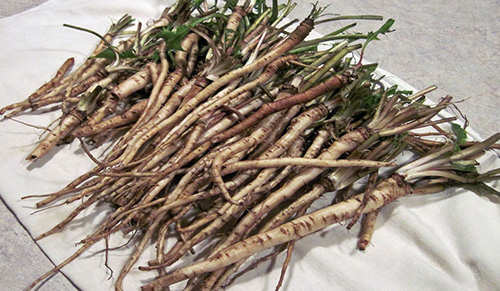 The yellow flower or furry “wish” tops and the edible leaves make this common plant very easy to distinguish. Its in most yards and on roadsides all over.
The yellow flower or furry “wish” tops and the edible leaves make this common plant very easy to distinguish. Its in most yards and on roadsides all over.
Related: How to Make Dandelion Bread (With Pictures)
Comfrey roots
Comfrey taken internally can be toxic. It is used as a salve for healing bones and the root can also be used as a gargle for throat conditions. Use the salve ration above to create your own comfrey salve.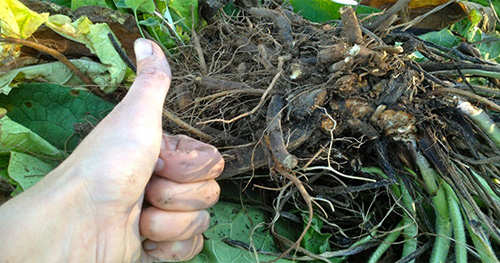 This plant is best identified using the small spearshaped leaves and the bell like flowers. It’s a small plant with a small flower.
This plant is best identified using the small spearshaped leaves and the bell like flowers. It’s a small plant with a small flower.
Burdock
Burdock is one of those roots that can get a little diluted in its effects. You can find literature that suggests burdock helps with basically anything! A powerful salve is one of the very best ways to help with skin ailments. Being high in C and E Vitamins you can also depend on burdock to help with immunity.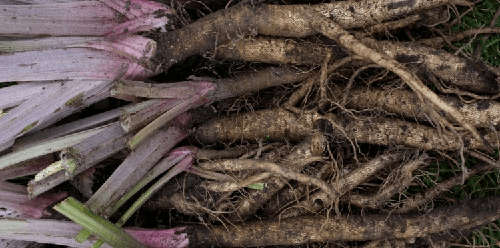 Of course, the prickly heads and the brilliant pink flowers are the best way to discern between other plants and this powerful medicinal plant.
Of course, the prickly heads and the brilliant pink flowers are the best way to discern between other plants and this powerful medicinal plant.
Related: Burdock: The Annoying Weed That Can Save Your Life
Nettle
There is a lot to say about nettle root but one things sticks out above all. You can take the root internally to help with enlarged prostate. You should use the root if you want the effects on the prostate. The leaves are also a nutritious food and once blanched they lose the 7 minute itch.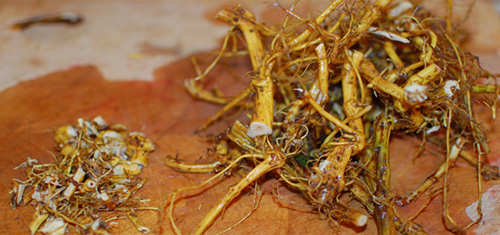 If you are looking to ID nettles look for these jagged leaves near a water source. If you want to be 100% sure, just reach out and touch some leaves. Be sure to bring gloves along if you don’t want to experience the stinging of the nettle.
If you are looking to ID nettles look for these jagged leaves near a water source. If you want to be 100% sure, just reach out and touch some leaves. Be sure to bring gloves along if you don’t want to experience the stinging of the nettle.
Related: How to Cook Spring Nettles
Poke
Poke root is one of those inflammation fighters that many people turn to with things like swollen glands, tonsillitis and even the effects of laryngitis. Be careful as the poke berries, leaves and stems are poisonous. Be careful of dosage as the root can be poisonous, too, in high doses.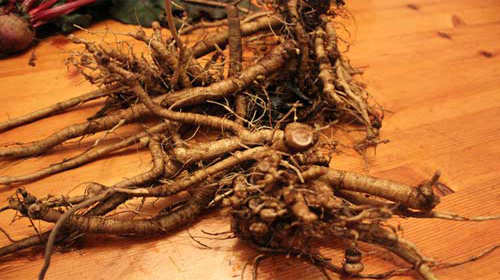 Pokeweed grows out of control if its allowed to. The brilliant dark purple berries look like something that should be edible but they are not. The long stalks and purple berries are by far the best way to ID this plant.
Pokeweed grows out of control if its allowed to. The brilliant dark purple berries look like something that should be edible but they are not. The long stalks and purple berries are by far the best way to ID this plant.
Leaves
Raspberry Leaf
One of the very best teas you can brew up is that raspberry leaf tea. It has a great taste and for the ladies it boasts things like increased fertility and even ease of labor. The latter I have trouble believing. It is both a powerful digestive aid and immune booster.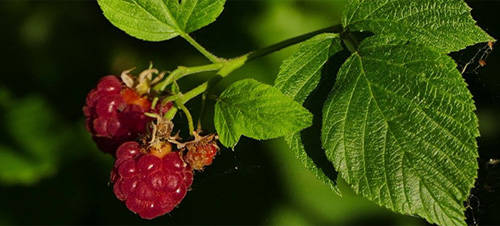 If the raspberries are gone than the best way to ID the raspberry leaf is to look for the simple three veined leaves on a thorned stalk. There will likely be remnants of the raspberries that were there, at the tips.
If the raspberries are gone than the best way to ID the raspberry leaf is to look for the simple three veined leaves on a thorned stalk. There will likely be remnants of the raspberries that were there, at the tips.
Jewelweed
The Jewelweed tincture is your best weapon against the brutal affects of things like poison ivy, sumac and oak. You can also use a poultice or decoction to treat the itching and the rash.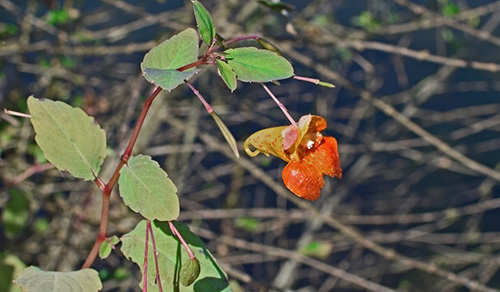 Jewelweed’s strange leaves have an almost blue hue to them and the red stalk is hard to ignore. This is another water’s edge plant like nettle. When its flowering it has an incredibly vibrant orange flower that literally pops out seeds when you touch it, thus the name spotted touch me not.
Jewelweed’s strange leaves have an almost blue hue to them and the red stalk is hard to ignore. This is another water’s edge plant like nettle. When its flowering it has an incredibly vibrant orange flower that literally pops out seeds when you touch it, thus the name spotted touch me not.
Rosemary
Rosemary is one of those gang buster herbs that attacks a little of everything. My recommendation is to have a little rosemary in everything. Put it in your salves, make a decoction, brew it in tea, spread it out everywhere. It’s a powerful antibacterial and its even a great incense to burn!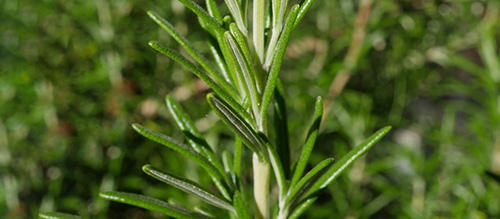 This garden herb is likely growing in your herb garden right now. If not ID this plant with its incredible tell tale smell. That strange pine like look and token rosemary scent is a dead giveaway.
This garden herb is likely growing in your herb garden right now. If not ID this plant with its incredible tell tale smell. That strange pine like look and token rosemary scent is a dead giveaway.
Berries
Elderberry
The elderberry tincture and its derivatives have long been a medicine that is used for cold and flu season. Now is the time to find these berries. This simple tincture can be made right in a mason jar and stored for when you need it most.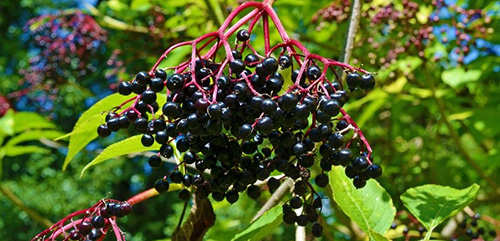 He clusters of dark berries can be confused with poke if you are new to foraging. There are many more berries and the elderberry is a bigger shrub than the simple pokeweed. ID with the berries and the reddish branches they hang from.
He clusters of dark berries can be confused with poke if you are new to foraging. There are many more berries and the elderberry is a bigger shrub than the simple pokeweed. ID with the berries and the reddish branches they hang from.
Rose Hips
A master immune booster rose hips are full of Vitamin C. Harvesting these little berries is dependent upon the weather. You really don’t want to forage for these until the first frost. You see, this pulls sugar into the rose hip and softens them.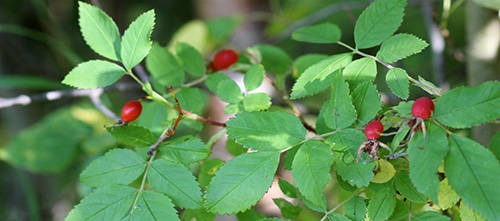 You can eat these straight away or make a tincture or even a tea of them.
You can eat these straight away or make a tincture or even a tea of them.
These are literally the fruits of the common rosebush. Where there were roses there will be rose hips. Pay attention in the spring and you will know where to find them in the fall.
Trees
Black Walnut
The juglone in black walnut husks is a powerful antifungal and can be used to treat skin conditions. The leaves and stems are also used to treat all sorts of things. Green walnut can be used to treat the respiratory system. It is toxic at high levels so be careful with this stuff. I would stay away from oral intake of black walnut.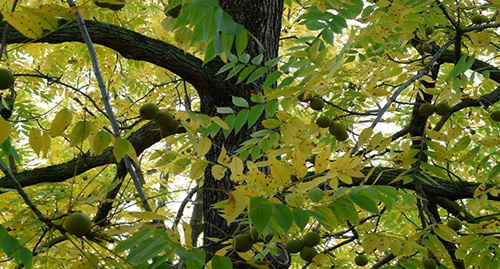 Walnut producing trees are big. They also drop lots of green husked walnuts that are very easy to ID in the Fall.
Walnut producing trees are big. They also drop lots of green husked walnuts that are very easy to ID in the Fall.
Related: 10 Trees Every Survivalist Should Know and Why
Weeping Willow
While the fact that willows have Salicylic acid in the bark most articles don’t talk about quantities. That is what you need to know. Of course, salicylic acid is the active ingredient in aspirin.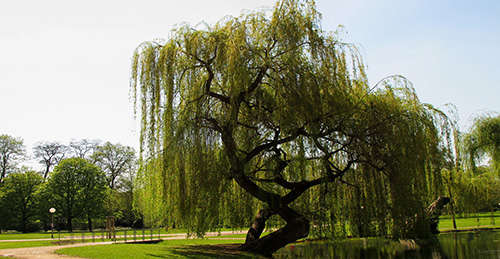 1 to 3 grams of bark in a tea or decoction is going to offer the body 60-120 mg of salicin. This can be used to deal with fever and pain.
1 to 3 grams of bark in a tea or decoction is going to offer the body 60-120 mg of salicin. This can be used to deal with fever and pain.
Willows are identified by their long thin pointed leaves. The weeping willow is often near water and has those hanging, or weeping, branches.
Foraging wild medicine in fall is a great practice, it’s a great activity for the family and it’s a process that is as old as some of our oldest civilizations. We have some powerhouse herbs and plants in this list but there are others out there.
From this base knowledge I encourage you to build a “menu” and a process by which you can take advantage of the wild medicine that the natural world produces every year. Learn how to process these plants. The simple processes listed above will not take much time and you will be able to stave off colds and illness by catching it early and using this medicine to heal you.
You may also like:
 September Crops for a Fall Harvest
September Crops for a Fall Harvest
This Bug Will Kill Most Americans During The Next Crisis (Video)
40 Bizarre Home Remedies Our Grandparents Taught Us That Actually Work
Delicious Recipes Using Cattails – “The Supermarket of the Swamp”

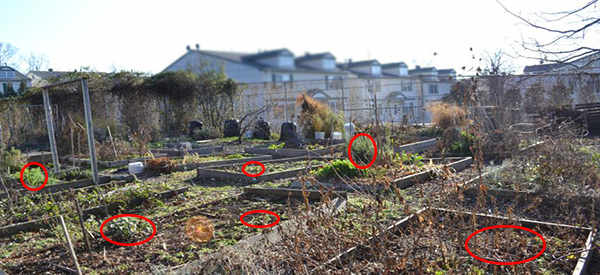













Salicylic acid is in aspirin, not tylenol!
Hi Linda,
Thank you so much for bringing this to my attention.
I have rectified the error.
Anne
That’s what he said, ASPIRIN
SALICYLIC ACID IS NOT THE ACTIVE INGREDIENT IN TYLENOL! IT IS THE ACTIVE INGREDIENT IN ASPIRIN!
Tylenol is acetaminophen.
The Smart & Final food outlet store near me has a selection of herbal teas. I noticed they had dandelion tea so decided that it presented an opportunity to try dandelion tea without digging up a mess of dandelion roots and drying them etc. Well, I don’t know if the company prepared it correctly or not, but it tasted mostly like dirt.
Burdock or in Japan, “gobo” is a standard vegetable in the Japanese diet. It is grown commercially and you can find it in any Japanese vegetable store. A favorite Japanese dish is made with carrots and burdock and is called chimera.
Check out Dandy Blend at health food stores, or look up on line for info.
Would like the book in paperback format, not digital
I feel the same about camomile. Taste like drinking dusty water to me.
Learn how to steep it. Buy untreated camomile. Mix the proper dose to taste.
Dandelion tastes a lot like chicory when the roots are roasted dark brown and brittle. Grind and brew as coffee…if you like it really strong and bitter you can boil it in a percolator.
Thank you for your comment on adding more to the article
Salicylic acid in willow is the active ingredient in aspirine not Tylenol. Tylenol is acetaminophen.
Comfrey root salve might be “used for healing bones” but is there any evidence it works? How would a salve ingredient get through the skin and muscle to the bone in high enough concentrations to affect bone repair or growth? And, if it could make it to the bone from the surface of the skin, what about that toxicity mentioned when taken internally? Good article in general, but I’m skeptical of this particular entry
A common name for comfrey is knitbone, precisely because it was a folk remedy that helped broken bones heal by using it as a poultice.
Your body’s largest organ is skin. As for how can it get through to help, perhaps you’ve used something like Ben Gay® to help when you’ve had aching muscles? Or IcyHot? The skin absorbs thing topically; if you rub a clove of garlic on the bottom of your foot, in a few minutes you will taste it in your mouth.
drops of dmso before putting on the salve could do the trick… look up the effect of dsmo on youtube but if you ask mee , daily sunbaths with lots of exposed skin, magnesium, eggs every day and all the green herbs, and bonebroth is what you need.. body can do it but needs minerals and enzymes. o.k. put in a dash of barleygrasspowder. (the grass dried not hotter then 40degrees Celcius because of the enzymes, at 50 Celcius they vanish)
MJ sounds like you have a wealth of helpful info too! Thanks
When I lived in Germany, the MD prescribed an antibiotic for my pneumonia. It was a salve in a tube that I was to rub on my chest. The salves were the preferred method of application of medicines.
Are you referring to POKE SALIT as POKE ?
You are mistaken about poison leaves… young,tender leaves are very popular in the south, boiled with hard-boiled eggs on top.
The berries and stalk are.
Poke, pokeweed, poke sallet – same thing. I also eat the stalks, after boiling in a couple of changes of water. I’m not dead yet. I have read that there are people who use the berries. I’ve never tried it.
I believe acetaminophen is the active ingredient in Tylenol. Salicylic acid is what aspirin is derived from.
Salicylic acid is in aspirin, not Tylenol
When is the best time to harvest wild lettuce? I’ve been protecting a patch from the mowers, but don’t know when to do what!
First of all, I am no Euell Gibbons. Generally the best time to harvest wild greens is when they are young and tender. As they get older the flavors tend to get more intense and sometimes bitter. Sometimes bitter is what is sought but I would think with lettuce, it would be best when the leaves were only a couple of weeks old or less.
If you want the lettuce to eat , you want to take the leaves when young if you want to make the pain killer you want to wait till it is a larger plant , then cut it down , shred it and do your cooking .at this stage what you want is the milky sap you see when you cut the stalk.
The black walnut -nut after being dried is very delicious and high in protein and very good baked in cookies, Or eaten raw However the green hull is the part to be careful with. but can be made into a very helpful medicinal potis
Both my daughters drank raspberry tea throughout their pregnancies. Both girls had easy deliveries. The drs were amazed at the slight amount of blood discharged. Raspberry tea works.
Regarding poke berries–it’s actually the seeds that are poisonous. The berries themselves are great for joints–swallow one or two dried berries, don’t chew, and the seeds will simply go right on through (and I’m still very much alive after doing so for some years now!) I have a friend who makes jelly or syrup from the berries–again, the seeds are removed and discarded. One caution, occasionally an individual may be sensitive to poke berries (so take only a little at first), but that can be said for nearly any medicinal.
you keep saying that poke berries and leaves are poison but they are not the leaves are very good although they can be strong we harvest and can poke salid every year and have done so my entire life we use the berries as a treatment for artritis and the stalk can be peeled and then fried like okra it can be to strong for some people but it is not poison
Jewel weed can also stop the Nettle Itch you will most likely find them together
Has anyone opined on creating different IV therapy solutions at home in a crisis. I am not a medical person, but IV fluids are numerous. Which ones are generically useful in SHTF scenario? Can they be made at home using different products? Where can they be purchased if unable to be made at home? Just looking to covering some bases!
These information are very valuable information and very appreciated of the article is obedy zorbs we could be healed on our body could be well taken care of using these herbs. And prevent us from using medication medication have a lot of side effect. With our bills using it just helps to keep your body in the right please and so thankful for all information on all the different herbs for the different things